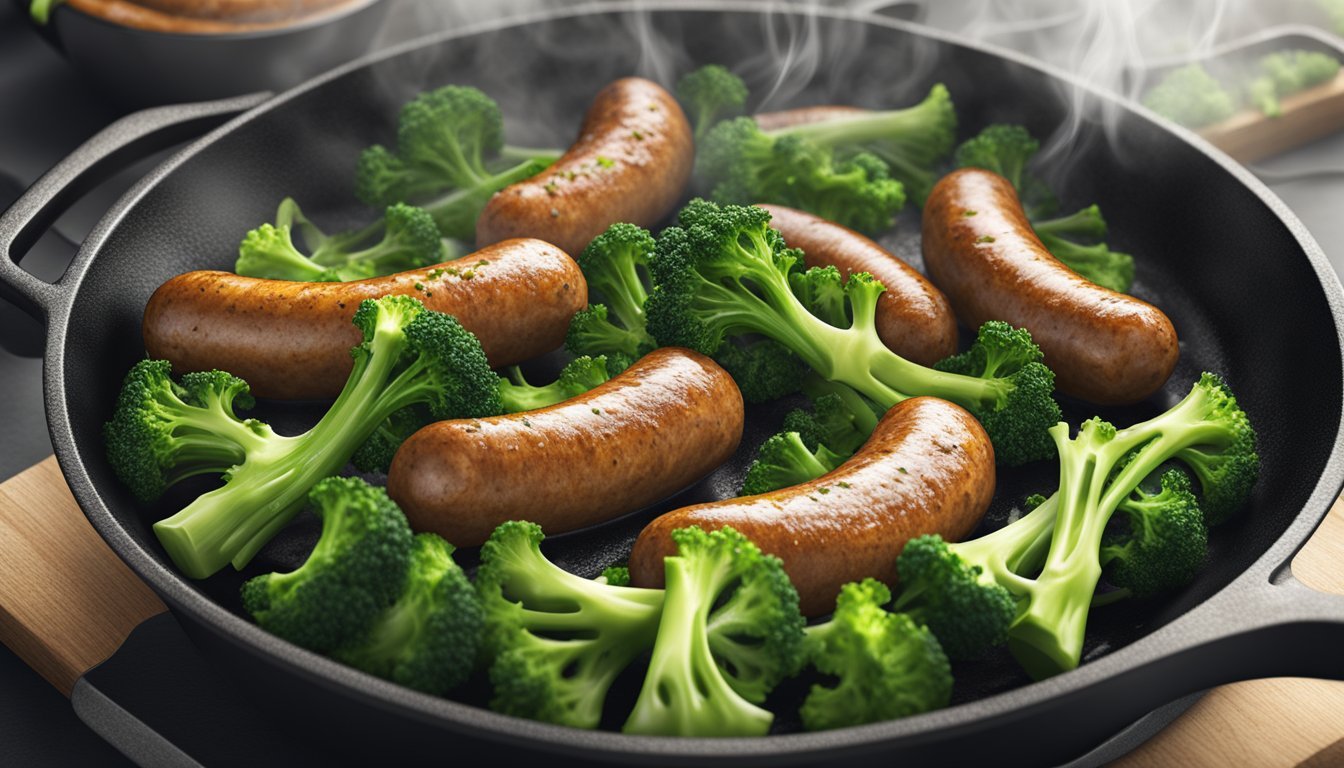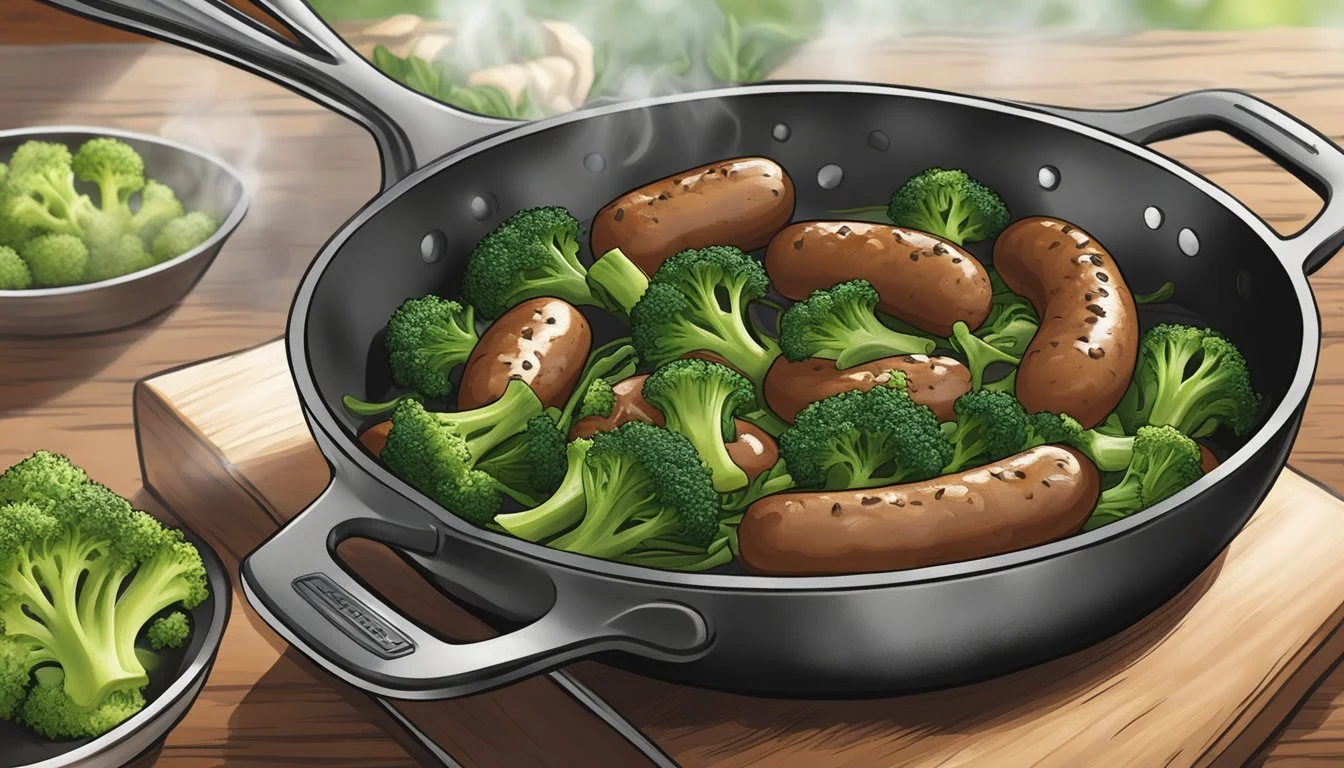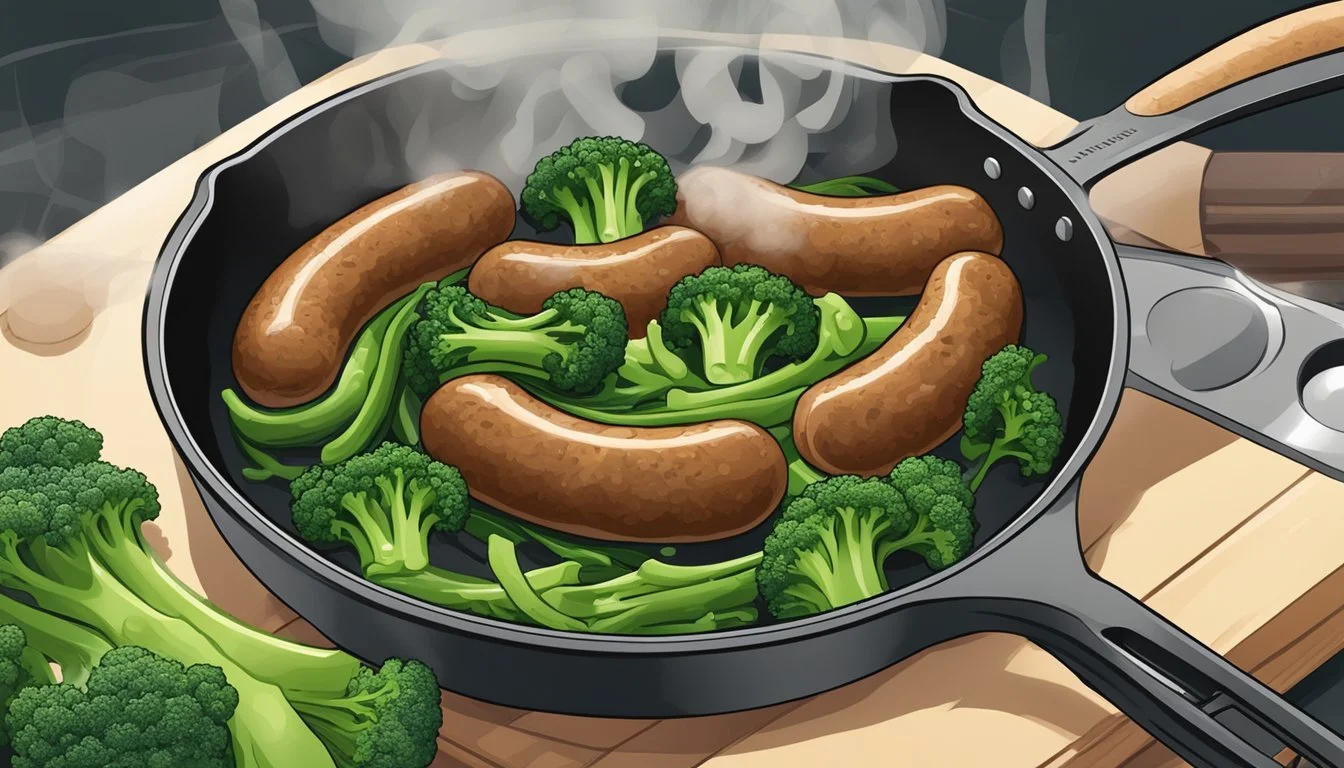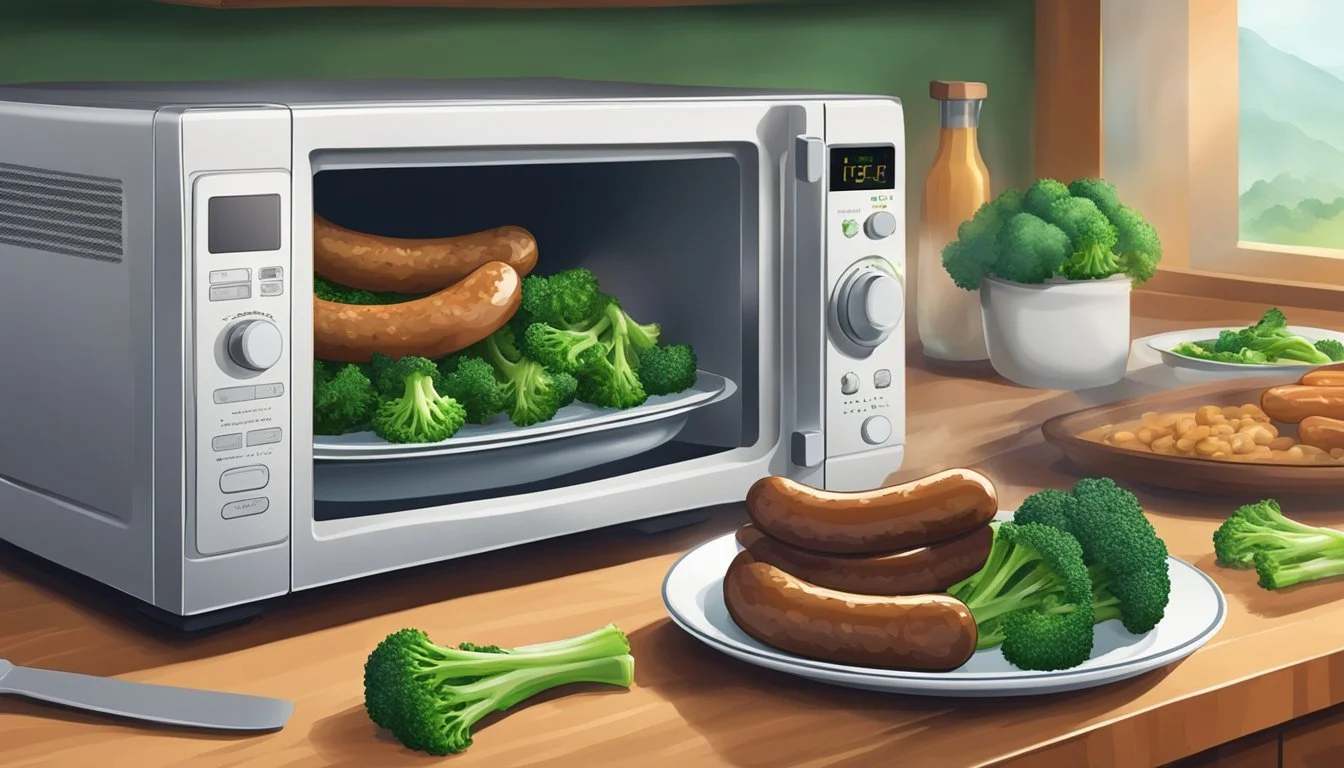Best Way to Reheat Sausage and Broccoli Rabe
Ensuring Flavor Preservation
Reheating dishes while preserving their original texture and flavor can be challenging, especially with items like sausage and broccoli rabe. Each component has its own set of considerations due to their different textures and cooking requirements. Sausage, being a protein, is susceptible to drying out if overheated, whereas broccoli rabe, a leafy vegetable, can become soggy and lose its vibrant green color if not reheated properly. To maintain the deliciousness of the dish, it's essential to employ the best reheating techniques that cater specifically to these ingredients.
When it comes to reheating sausages, the key is to use a method that warms the meat evenly without causing it to lose its juiciness. An oven set to a moderate temperature allows for a uniform distribution of heat, while covering the sausages can keep them moist. On the other hand, broccoli rabe requires a gentle touch to avoid overcooking. Utilizing a quick and efficient method that applies just enough heat to restore its warmth without turning it mushy is crucial for maintaining the integrity of the greens.
By understanding the nature of these foods and how they react to heat, one can ensure that even after reheating, sausage maintains its succulence and broccoli rabe its tender bite. The objective is to revive the dish to its peak state, as if it were freshly made, so that every reheated meal is just as enjoyable as when it was first prepared.
Understanding Sausage and Broccoli Rabe
This section delves into the distinctive qualities and healthful aspects of sausage and broccoli rabe, as well as their culinary harmony when combined.
Characteristics of Sausages
Sausages come in countless varieties, but generally, they consist of ground meat, often pork, encased in a cylindrical shape. Italian sausages, frequently used with broccoli rabe, are seasoned with a blend of spices including garlic, fennel, and red pepper flakes. The texture varies from finely ground to coarsely chopped, leading to differences in mouthfeel and flavor release.
Flavor Profiles:
Italian Sausages: Rich flavor infused with spices; mild to spicy levels
Pork Sausage: Robust taste, often complemented by savory seasonings
Texture Considerations:
Fine Ground: Smooth, homogenous consistency
Coarse Ground: Chunkier, more pronounced bite
Health Benefits and Nutritional Values of Broccoli Rabe
Broccoli rabe, also known as rapini, is not only notable for its slightly bitter taste but also for its rich nutritional profile. It is a good source of vitamins A, C, and K, as well as minerals like calcium and iron.
Nutritional Highlights:
Vitamin A: Supports eye health
Vitamin C: Vital for the immune system
Calcium: Important for bone health
The bitterness, which some find pleasant, can be balanced by cooking methods that typically include blanching or sautéing with olive oil.
The Fusion of Sausage and Broccoli Rabe in Cooking
When sausage and broccoli rabe converge in cooking, it's a marriage of robust, meaty richness with earthy, green bitterness. This combination is classic in Italian cuisine, often finding harmony with garlic and olive oil.
Culinary Pairing Techniques:
Sautéing: Enhances the natural flavors and textures of both components
Blanching: Reduces bitterness in broccoli rabe, making it a more subtle counterpart to the sausage
By understanding these elements, one can preserve and enhance the flavors when reheating sausage and broccoli rabe dishes.
Preparation Strategies Before Reheating
To ensure sausage and broccoli rabe retain their robust flavors when reheated, one's approach to prepping and storing is crucial. The nuances of pasta storage, specifically orecchiette, also play a fundamental role in the preservation of texture and taste.
Proper Storage Techniques
Sausage and broccoli rabe should be stored separately in airtight containers to maintain their distinct flavors and ensure optimal freshness. If there are leftovers from a meal, prompt refrigeration is key — ideally within two hours of cooking. Here's a guideline:
Sausage: Place in an airtight container, single-layered to avoid moisture buildup, which can affect texture.
Broccoli Rabe: After cooling, store in an airtight container lined with paper towels to absorb excess moisture.
Freezing: If not planning to eat within 3-4 days, consider freezing. Wrap tightly in foil or plastic wrap before placing in containers to prevent freezer burn.
Pasta Considerations for Orecchiette With Broccoli Rabe
Orecchiette, with its unique shape that holds sauces well, requires special attention to preserve its al dente texture. To prevent sticking together when reheating:
Cooling: Before storing, drizzle with olive oil and allow the pasta to cool. This creates a light coating that prevents clumping.
Storage: Use a shallow container to store orecchiette, spreading them out to keep their shape intact.
Prep Time: When prepping to reheat, consider removing the orecchiette from the refrigerator a few minutes in advance to bring them closer to room temperature for even reheating.
Remember, the care taken in storage will reflect in the reheating results, offering a meal that is nearly as fresh as when initially prepared.
Reheating Sausage and Broccoli Rabe
Proper reheating is crucial to maintain the tender texture of sausage and the vibrant color and crunch of broccoli rabe. Each method is suited to specific textures and flavors.
Using the Oven for Even Heating
To reheat sausage and broccoli rabe evenly, the oven is a reliable method. Wrap the sausage in aluminum foil to retain moisture and place it on an oven-safe dish. Then, lay the broccoli rabe in a single layer beside it. Reheat at 325°F (165°C) for 10-15 minutes, checking to ensure even heating without overcooking.
Stovetop Reheating for Enhanced Flavor
Sausage reheated on a skillet or stovetop can develop enhanced flavors. Heat a small amount of oil in a skillet over medium heat. Add the sausage, turning regularly for an even heat distribution, for about 4-7 minutes or until the internal temperature reaches 165°F (74°C). Briefly sauté the broccoli rabe with a splash of water in the same skillet to restore its vibrant color and moisture.
Microwave Techniques to Avoid Overcooking
To reheat sausages and broccoli rabe quickly, the microwave can be a viable option to avoid overcooking. Place the sausage on a microwave-safe plate, cover with a damp paper towel to retain moisture, and heat on medium power in 30-second intervals, checking after each. For the broccoli rabe, a short reheating time likewise under a damp paper towel can preserve texture and moisture.
Enhancing Flavor During Reheating
Reheating sausage and broccoli rabe dishes requires careful consideration to preserve their savory and spicy profiles. The section below maps out methods to ensure that the reheated dish is as flavorful as if served fresh.
Infusing with Aromatics and Spices
To enhance the flavor of sausage and broccoli rabe during reheating, one can introduce additional aromatics and spices. Adding a small amount of minced garlic cloves or scattering a pinch of crushed red pepper flakes can infuse the dish with a bold and aromatic edge. A subtle drizzle of olive oil may also carry the flavors well and prevent them from becoming muted.
Maintaining Moisture and Preventing Dryness
Moisture retention is paramount in preserving the taste and texture of sausage and broccoli rabe. One can lightly coat the sausage with a high-smoke-point cooking oil to form a barrier against dryness. Covering the dish snugly with foil during oven reheating keeps the steam in and ensures that the sausage and vegetables remain moist, ultimately preserving their natural flavors.
Tip: For oven reheating, maintain a temperature of 350°F (175°C) and bake for about 10-15 minutes.
Utilizing Sauces and Condiments
The addition of sauces or condiments can immensely enhance the final result. A modest spoonful of high-quality Italian sauce or a sprinkle of aged Parmigiano Reggiano or Pecorino Romano cheese can add depth and invigorate the inherent flavors. For a spicy iteration, a touch of black pepper may amplify the robust personality of a spicy Italian sausage-based dish.
Condiment Guide:
Parmigiano Reggiano: Adds a nutty and rich flavor
Pecorino Romano: Offers a sharp and tangy note
Black Pepper: Provides a warm and spicy kick
Post-Reheating Tips
After reheating sausage and broccoli rabe, one should focus on attaining the ideal serving temperature, presentation, and food safety to ensure the dish retains its flavors and qualities typical of Italian cuisine.
Ensuring Optimal Serving Temperature
The ideal internal temperature for reheated sausage should be 165°F, as this ensures the meat is heated through and maintains tenderness. One can use a meat thermometer to check this. For broccoli rabe, it is vital that it is warm yet still vibrant in color, showing that it has not been overheated. To maintain an even temperature throughout, one might let the dish rest for a couple of minutes before serving, ensuring that the heat distributes evenly.
Garnishing and Presentation Recommendations
When presenting sausage and broccoli rabe, one should pay attention to enhancing the visual appeal and taste. A light sprinkle of crushed red pepper flakes can add both color and a hint of spice. If one seeks to accentuate the authentic flavors, adding a garnish of mustard greens may complement the bitterness of the broccoli rabe. As for the sausage, presenting it on a platter with thoughtful arrangement can make it more inviting for meals such as breakfast, lunch, or dinner.
Food Safety Considerations
One should never leave sausage and broccoli rabe at room temperature for more than two hours to avoid entering the danger zone for bacterial growth. Leftovers need to be stored promptly in the refrigerator. For reheating, if using a microwave, it's crucial to ensure the food is reheated evenly, stirring or rotating as needed. The total time for refrigerated leftovers to be consumed should ideally be within three to four days to minimize the risk of foodborne illnesses.
Alternative Uses for Leftover Sausage and Broccoli Rabe
With creativity, one can transform leftover sausage and broccoli rabe into delectable dishes that revitalize their flavors. Utilizing these leftovers not only minimizes food waste but also extends the enjoyment of a previous meal into new culinary experiences.
Innovative Recipe Ideas
Pasta Integrations: Incorporating diced sausage and chopped broccoli rabe into pasta dishes adds a savory depth. Whether tossed with a garlic-infused olive oil or mixed within a creamy Alfredo sauce, this combination infuses Italian flair into the meal.
Frittatas or Omelets: For a hearty breakfast, sauté the broccoli rabe and sausage, and then fold them into a frittata or omelet. The robust flavors of the sausage and the slightly bitter notes of the broccoli rabe will enrich the simple egg base.
Creating Sausage Casseroles and Sausage Rolls
Sausage Casseroles:
Preheat oven to 375°F and lightly grease a baking dish.
Layer sliced sausage and broccoli rabe with your choice of cheese and pasta or rice.
Pour a mixture of egg and milk over the layers, allowing it to soak.
Bake until the casserole is set and golden on top, enhancing both flavor and texture.
Cut the sausages into smaller chunks and mixing them with finely chopped broccoli rabe.
Lay out puff pastry sheets on a baking tray, place the sausage and broccoli rabe mixture along one edge, and roll snugly.
Bake in a preheated oven at 400°F on a lined baking sheet until the rolls are puffed and golden, adding a British twist to the Italian ingredients.
Troubleshooting Common Reheating Problems
When reheating sausage and broccoli rabe, the main challenges are maintaining moisture for tenderness and preventing overcooking, which can result in a loss of flavor and less enjoyable texture.
Dealing with Dry or Tough Sausages
Dry or tough sausages result from excessive reheating, leading to moisture loss. To combat this:
Start with a preheated oven at a moderate temperature, around 325°F (165°C), to ensure gradual heating.
Keep sausages covered with foil on a baking tray to trap steam and maintain moisture.
If sausages appear dry
Preservation and Long-term Storage
Proper storage of sausage and broccoli rabe is crucial for maintaining flavor and safety. Initially, one should allow the leftovers to cool to room temperature before storing them. Freezing is the preferred method for long-term preservation.
Sausages: they can be stored in the freezer to extend their shelf life. It is recommended to:
Wrap individual sausages in cling film or aluminum foil.
Place them in an airtight container or a heavy-duty freezer bag.
Label with the date to keep track of freshness.
By wrapping sausages individually, one can prevent freezer burn, a condition where frozen food's surface dries out, leading to a change in texture and flavor.
Broccoli Rabe: to freeze broccoli rabe, these steps will help retain its texture and nutrients:
Blanch the greens in boiling water for two to three minutes.
Cool them quickly in ice water.
Drain thoroughly to remove excess moisture.
Pack the blanched broccoli rabe in airtight containers or freezer bags.
When both sausage and broccoli rabe are ready for storage, place them in the coolest part of the freezer. This method can keep the items fresh for several months. However, they should be consumed within three months for optimal flavor. Regularly check your freezer to ensure it is functioning at the correct temperature and there are no signs of freezer burn on the food.
Remember, the key to successful storage and later reheating is to prevent exposure to air and moisture. Using proper containers and prompt freezing will go a long way in preserving the quality of your food.





